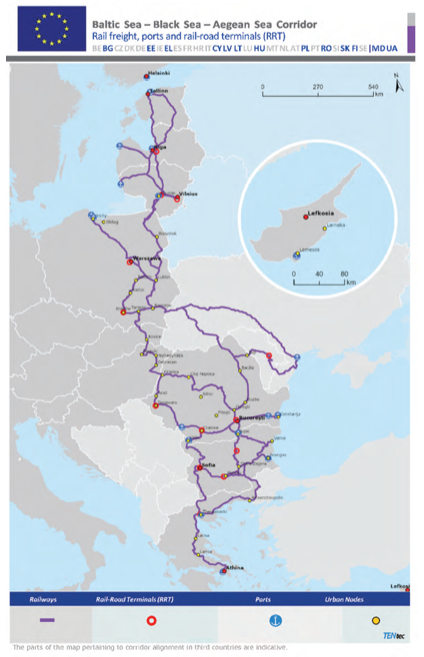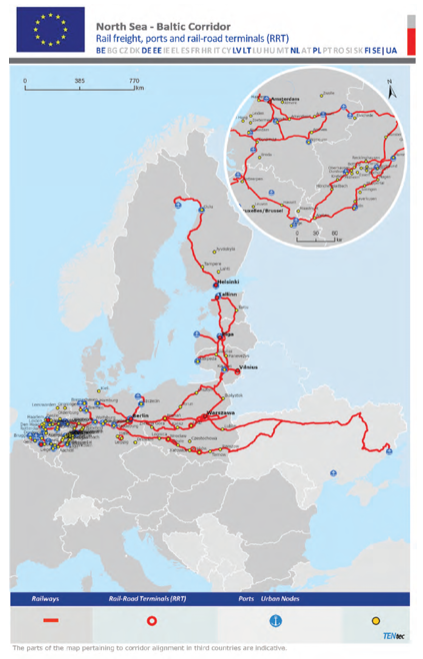On Thursday, July 18, the revised regulation of the Trans-European Transport Network (TEN-T) comes into force, aimed at improving the connectivity, efficiency, resilience, and sustainability of European transport infrastructure. According to the revised regulation, Rail Baltica is part of two European transport network corridors. In addition to the North Sea-Baltic corridor, Rail Baltica is also designated as part of the Baltic Sea- Black Sea – Aegean Sea corridor. Inclusion in these two corridors underscores the strategic importance of Rail Baltica on a European scale and will facilitate support and funding in the future.
“The Ukrainian side positively values Rail Baltica’s official inclusion in yet another TEN-T corridor extending to Ukraine and remains committed to cooperation. This collaboration will enhance export opportunities for all involved countries and strengthen regional connectivity, integration, and security. In addition to the economic benefits, Ukraine’s indirect participation in Rail Baltica would promote its integration into existing European transport corridors and complement its involvement in the Three Seas Initiative. We are ready to actively cooperate with Latvia, Lithuania, Estonia, Poland, and the European Commission in conducting feasibility studies for Ukraine’s inclusion in the Rail Baltica project,” emphasized Anatolii Kutsevol, Ambassador Extraordinary and Plenipotentiary of the Republic of Ukraine to Latvia.
“The “Solidarity Lanes” allowed Ukrainian exports to stabilize when Russian forces blocked Ukrainian ports. Currently, Ukrainian Railways systematically work to expand transport infrastructure capacity with the EU countries, primarily developing intermodal routes to the Baltic States. A strategic priority is integrating Ukraine’s rail infrastructure into TEN-T corridors, connecting our network with Rail Baltica as part of the Baltic Sea-Black Sea-Aegean Sea corridor. This will enable Ukraine to open new rail routes to the EU sea ports in the future,” stated Yevgen Lyashchenko, Chairman of the Board of JSC “Ukrzaliznytsia”.
Rail Baltica will create a functional high-speed rail transport corridor that promotes full integration of the Baltic States into Europe, enhances military mobility, and supports long-term regional economic growth. Furthermore, Rail Baltica’s inclusion in this transport corridor will be significant for Ukraine’s reconstruction. Currently, the implementers of the Rail Baltica project are already collaborating with Ukraine, sharing knowledge, providing insights into infrastructure project development, and facilitating practical experience exchange.
“The strategic importance of Rail Baltica is growing not only considering the geopolitical situation in Europe but also the expansion of the unified European transport network corridors and future connections with Ukraine. The Rail Baltica project will serve as a strong foundation for establishing a new economic and security corridor, and cooperation and support between the Rail Baltica project implementers and Ukraine are crucial for our collective security,” stated Marko Kivila, CEO and Chairman of the Board of RB Rail AS.
The new TEN-T Regulation sets phased deadlines: core network by 2030, extended core by 2040, and comprehensive network by 2050. A 2040 interim deadline accelerates key cross-border projects like rail connections. Emphasizing multimodal transport, sustainability, and digitalization, it supports EU goals of reducing carbon emissions and economic growth.
For Rail Baltica, the regulation is relevant for enhanced EU funding access for railway projects, standards like mandatory ERTMS deployment by 2030 (core) and 2040 (extended/comprehensive networks). It aligns with Rail Baltica’s aim to cut emissions, improve travel times, shift traffic to rail, and boost regional economies. Strengthening cross-border cooperation, it ensures project completion, enhances connectivity, and prioritizes safety and security measures.
Background Information:
The proposal to revise the TEN-T was adopted by the Commission in December 2021 as part of the legislative package for efficient and green mobility, aligning the network with the objectives of the European Green Deal. In May 2022, the Commission expanded transport corridors to include Ukraine and Moldova, while excluding Russia and Belarus. The Council adopted its general approach in December 2022, and the European Parliament’s Committee on Transport and Tourism approved its report in April 2023. Trilogue negotiations concluded in December 2023, with the agreement formally adopted by the Parliament in April 2024 and by the Council in June 2024.


